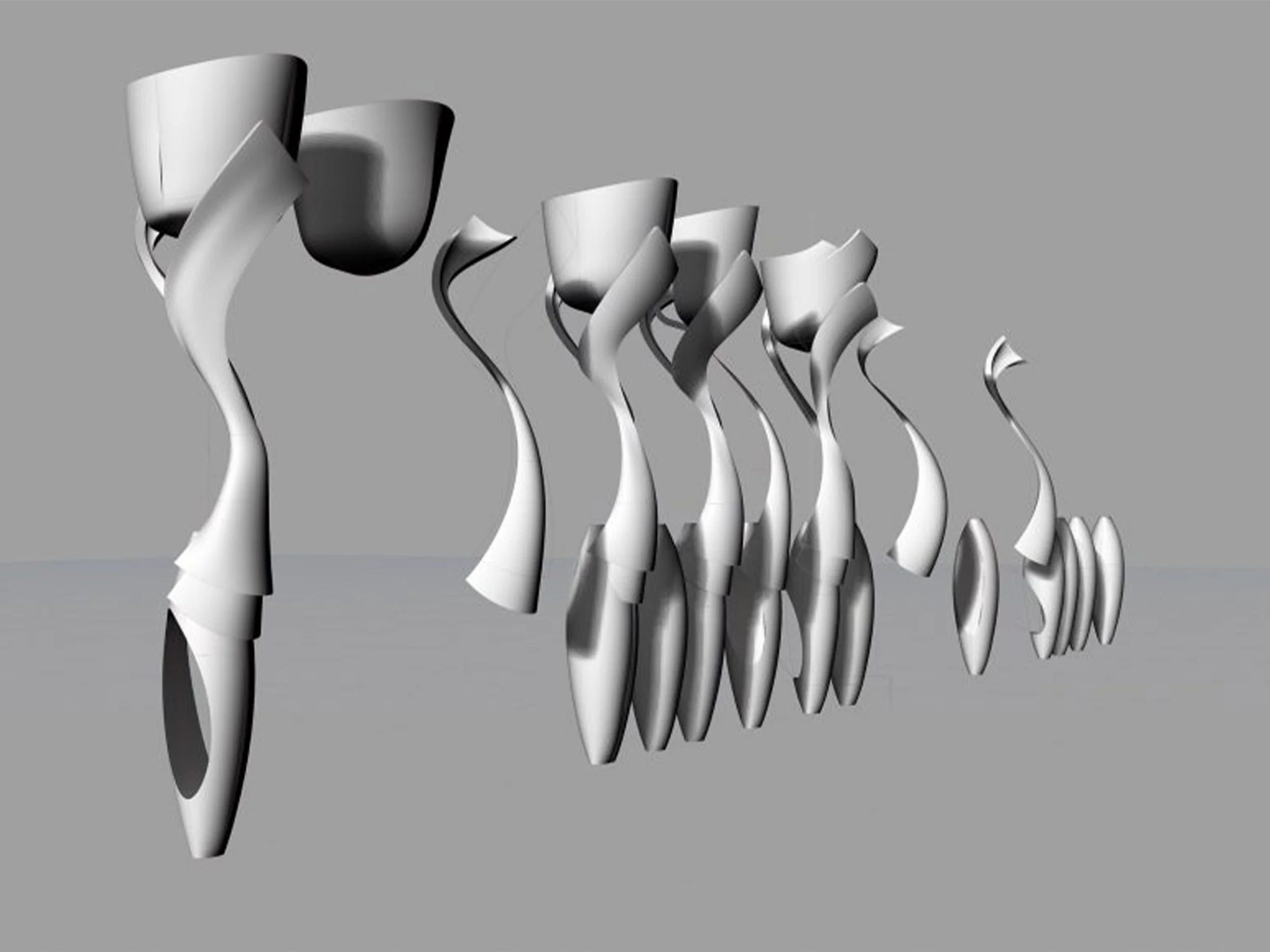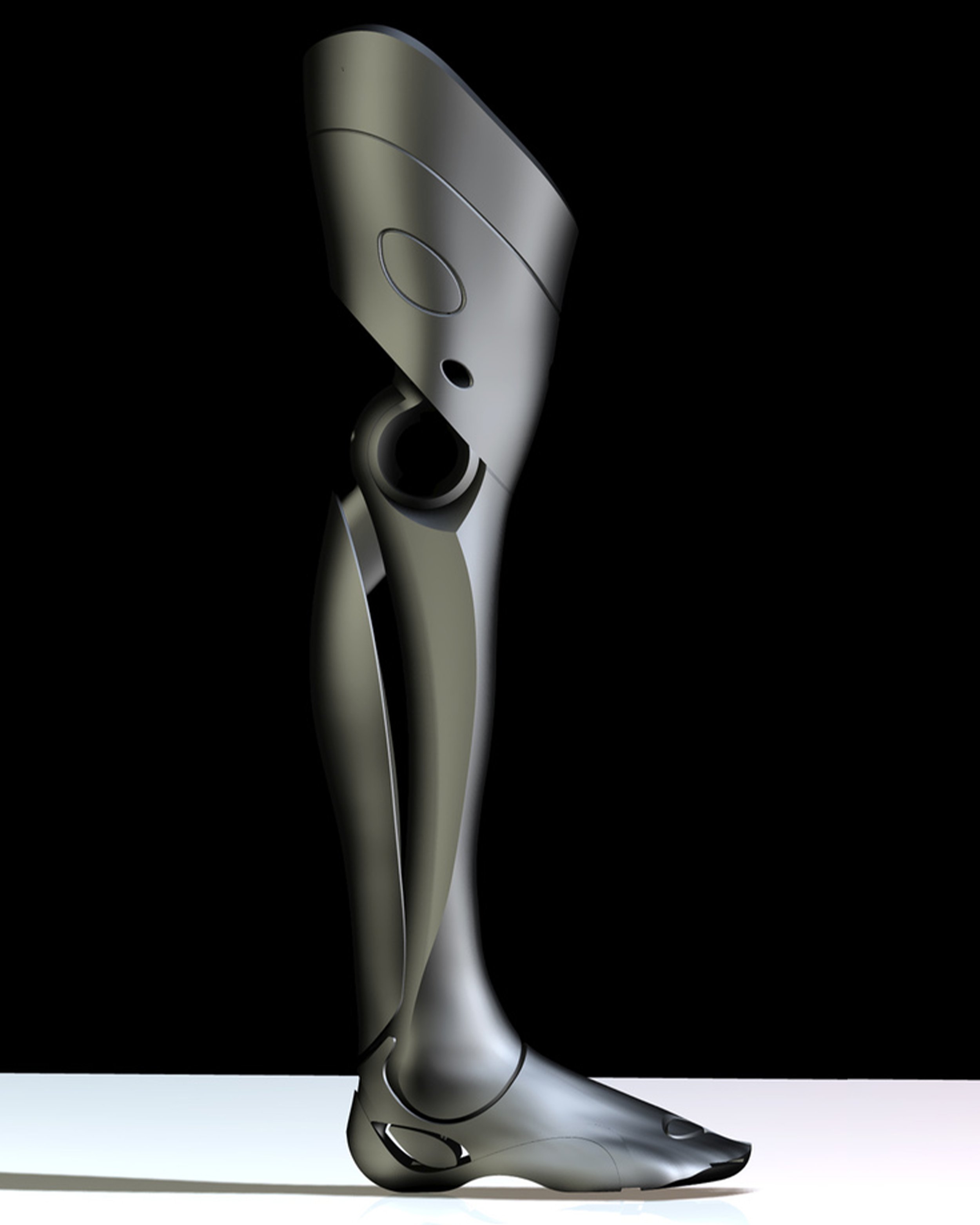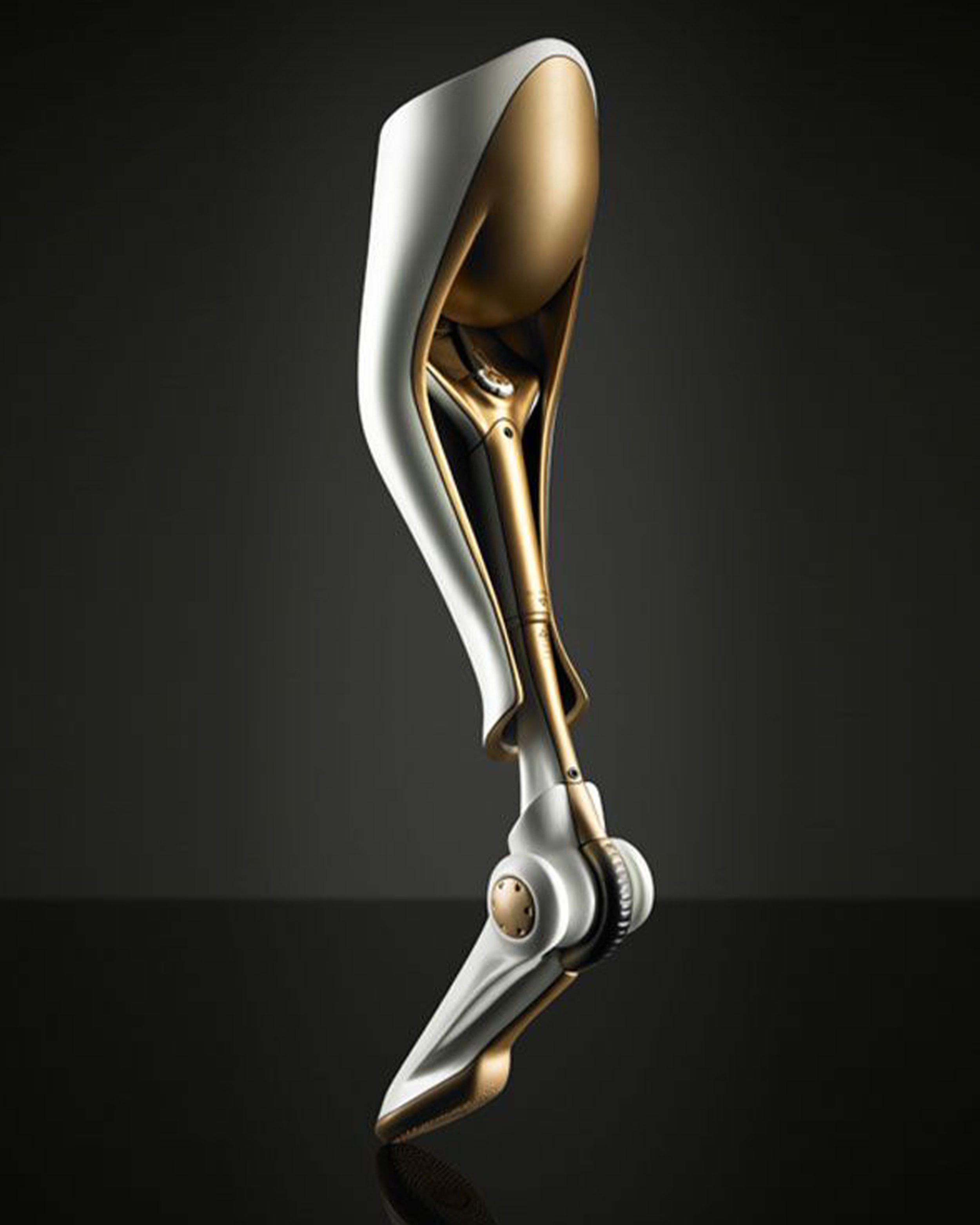Sole Systems 005: Prosthetics
Advanced Human Potential
Words by William Penny
In this instalment of Sole Systems, we take a look at the past, present, and future technologies associated with leg prosthetics and how good design not only replicates nature but aims to improve upon it. We’ll look at how engineers have pioneered technology which allows people to become fully at one with their prostheses and the people who are challenging our practical and conceptual understanding of prosthetics. Can the next step in human evolution be technological rather than biological?
One of the earliest mentions of leg prosthetics can be mapped back to 430 BC where ancient Greek historian Herodotus tells the story of Hegesistratus, a diviner who escaped the clutches of the Spartans by cutting off his own foot and replacing it with a wooden one. For centuries designers and engineers have grappled with the complexities of creating suitable and affordable prosthetics that give amputees freedom of movement and independence. Despite obvious technological advances since the story of Hegesistratus, current amputation practices haven’t changed fundamentally since the American Civil War, practices which have grown obsolete in light of dramatic advancements in the materials and technology. We’re going to take a look at examples of pioneering designs that have not only allowed amputees to live active lives once again but enabled them to push beyond the boundaries of human achievement. In the words of Hugh Herr, “a person can never be broken, only technology is broken.”
Prosthetic Foot
The foot of a prosthetic leg is perhaps the most important part of the design as it is the part that grounds the user to a surface, carrying the weight of the body and giving stability through grip and balance. The most common type of prosthetic foot is constructed from crepe neoprene or urethane foam which is moulded to mimic a human foot and is placed over a reinforced inner keel usually made from carbon fibre, acrylic resin, titanium, or aluminium and only offers a basic level of support and visual similarity. Dynamic models feature flexible keels which are able to store and release energy during walking to give the wearer a sense of pushing-off from the ground, allowing a more natural style of walking.
After having both legs amputated below his knees American engineer and climber Hugh Herr began developing his own specialised foot attachments which not only allowed him to continue climbing but gave him the tools to push beyond the limits that his biological legs had given him. Realising that his new body was malleable he was able to create narrow-edged foot attachments to utilise fissures which the human foot would fail to grasp as well as spiked foot attachments that allowed him to climb vertical ice walls. Herr was also able to determine the length of his prosthetic legs, he could be anywhere between 5 and 8-feet tall meaning he could complete climbs that even the most accomplished able-bodied climber could not achieve. The purpose of a prosthetic leg for Herr was not just to reaffirm what is considered a ‘normal’ body but to unlock a new potential that is not afforded to the abled body.
The attachments that Herr engineered for himself in the eighties have DIY charm which is at odds with the precise technological glean of the products he creates nowadays at the MIT Media Lab where he directs a Biomechatronic research group. To allow prosthetics to move in a more fluid way Herr and his team have developed prosthesis fitted with EMG sensors that measure and decode the electrical impulses in the muscles of the residual limb which can then be translated into movement – carbon fibre and mechanical elements move as if they are flesh and bone. This huge technological leap from a passive prosthetic foot to a bionic one means that users can learn to walk on their new legs with little training and rehabilitation, they control their leg in much the same way that you would control a biological leg, whereas passive non-bionic prosthetic limbs can take months or years to learn how to use, with some people never even being able to fully adjust to life on a passive prosthetic.
Cheetah Blade
Perhaps the most instantly recognisable leg prosthesis is the infamous Cheetah Blade, a high-performance sport silhouette used by athletes affectionately known as ‘bladerunners’. While the more conventional prosthetic legs that are used in daily life look to recreate the movement of a human leg, the speed focused Cheetah Blades look somewhere more appropriate for inspiration, the world's fastest land mammal. Based on the bowed hind legs of a cheetah, the Össur manufactured blade combined human and animal to create a hybrid that looks to push the human body beyond its known potential. Cheetah Blades utilise up to 90 layers of carbon-fibre reinforced polymer which is a strong and ultra-light-weight material usually reserved for high performance Formula 1 cars. These prosthetics are designed with speed in mind, they’re made only to move forward and offer no back support, that paired with the bounce inherent in the shape and material mean that Cheetah Blades are incredibly difficult to use and are a testament to the hours of training athletes put into their performance. The design and development of Cheetah Blades have been so successful that in 2020 an International Olympic Committee decided that athlete Blake Leeper wouldn’t be allowed to race in the Olympics against able bodied competitors because his blades would give him an unfair advantage. One of the early pioneers of Cheetah Blades was Aimee Mullins, the first athlete to utilise this style of prosthetic competitively in the 1996 Atlanta Paralympics used the term “super-abled” to describe the success of the Cheetah Blade in allowing her to surpass her potential on prosthetic legs.
Add-on Treads
For the 2012 London Paralympic games industry leading prosthetic manufacturer Össur teamed up with Nike to develop the Nike Sole 2.0, designed specifically for the Ossur Flex-Foot Cheetah Blades. Astonishingly, before Nike created these custom soles athletes would have to create their own DIY grips by detaching soles from existing trainers and glueing them to the underside of their Cheetah blades. The DIY approach adopted by athletes up until that point was time consuming and often caused damage to blades, the interchangeable sole system developed by Nike made it possible for athletes to change their soles in seconds and offered a larger variety of sole types. Rather than designing prosthetics to replicate feet so that the athlete can wear footwear the two companies used this opportunity to create something completely new. Asics is another sportswear company that has dipped its toe into prosthetic development by partnering up with Xiborg, to produce a similar set of track spikes that can be attached to running blades.
A similar contribution made by manufactures more commonly associated with footwear occurred when MIT Media Lab and Jaipur Foot enlisted the help of Vibram to develop a covering for a more cost-effective prosthetic foot which closely mimics the manner of walking on a biological foot. The prosthetic foot which is composed of a single unit doesn’t aim to replicate the mechanics of a foot but focuses on allowing a more fluid movement of the lower leg by utilising a scaled down shape similar to that used on Cheetah Blades.
Accessible Designs
Despite the strides that have been made in prosthetic design to bridge the gap between disability and ability, one of the major obstacles the industry has to deal with is cost and accessibility. What good is pushing the capabilities of human potential if these creations are ultimately unattainable for those who need it the most?
Project Circleg, spearheaded by Industrial Designers Fabian Engel and Simon Oschwald, looks to combat the inaccessibility of prosthetics by looking to utilise plastic waste reinforced with glass fibre as a cheaper alternative to the likes of carbon fibre and solid aluminium joints. While the prosthetic is much more basic, the Circleg offers a much needed affordable alternative to allow people immediate mobility and independence. The Circleg is a dynamic prosthetic complete with a swing-back knee mechanism and ankle joint, these simple dynamic additions allow the wearer to walk with ease and to even kneel and squat down offering increased mobility.
Designer Desiree Riny took this commitment to accessibility once step further by publishing a ‘DIY Prosthetic Manual’ which offers guidance on how amputees can create their own prosthetics using spare bicycle parts and other scrap materials. This project speaks to the fact that the cutting edge technology adopted by the likes of Ossur and MIT Media Labs means very little to the vast majority of amputees if they simply cannot afford to access it.
To prepare for the 2016 Rio Paralympic games, athlete Denise Schindler worked with Autodesk to explore the potential of 3D printing and scanning technology to create a high-performance prosthesis capable of performing in competition. Schindler and her team used advances in technology in order to create an affordable high-performance prosthetic which could be used by many, not just a few. Swapping plaster casting for 3D scanning, socket design for digital sculpting, and carbon fibre moulding for 3D printing Schindler and the Autodesk team created a high-performance prosthesis for a fraction of the cost.
Conceptual Prosthetics
As well as pioneering high-performance prosthetics for competitive athletes, Aimee Mullins has encouraged conversations about disability away from just basic needs and sporting accomplishments to more conceptual pursuits such as art and fashion. In conversation with Harold Koda at the MoMA in New York, Mullins explained that rather than using her disability for “some kind of social commentary” she wanted to explore something seemingly frivolous, like fashion. This desire to take extraordinary design off the running track and into galleries and runways illustrates the restricted and often medical nature that prosthetic design has been confined to for most of her life. Mullins desire to move away from the need to replicate humanness as the only aesthetic ideal is very much at the centre of her collaborations with the likes of Alexander McQueen, Nick Night, and Matthew Barney. After collaborating with McQueen and Knight for the September 1998 ‘Fashion-able’ issue of Dazed and Confused magazine, Mullins opened Alexander McQueen’s Spring/Summer show wearing a custom pair of wooden prosthetic legs. The wooden legs, created from a solid piece of ash, were hand carved to fit Mullins exact measurements so they could be worn without straps or support and finished with intricate Louis XIV style carvings.
The privilege of being able to create unique prosthetics that push beyond the realms of everyday practicality is no longer exclusively available to athletes and models. The relatively inexpensive and more readily accessible process of 3D printing has allowed designers to create special prosthetics on a larger scale for clients who otherwise wouldn’t be able to experiment with the possibilities of prosthetics. 3D printed prosthetic legs that allow amputees to perform ballet were created by Jae-Hyun An at the Pratt Institute in New York. Named after the Swedish ballet dancer Marie Taglioni, the Marie-T is designed specifically for enhancing the dancer's performance and serves no purpose away from the stage.
Despite all the technological advances that have been made in prosthetic design in recent history there has been little attention given to these developments from within the footwear community. At CONCEPTKICKS we’re keen to learn about the technologies that can push footwear design forward, so we’re taking a look at how prosthetic design has recontextualised footwear entirely.
In assessing the evolution of prosthetics from a design point of view it’s clear to see that there’s a wealth of knowledge and ideas ready to be picked up by footwear designers. In peeling back the silicone façade we can uncover the life changing and boundary pushing design that has helped people replace lost limbs for hundreds of years, from Hegesistratus’ primitive wooden foot to 3D printed works of art. Let’s hope that footwear designers can look to figures like Hugh Herr and Aimee Mullins to inspire how cutting-edge technology and outside-the-box innovation can create footwear that carries us into the future, leaving nobody behind.























